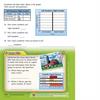Similar presentations:
Basic English: Introduction. Lesson 1
1.
Motivation: "To be a nurse is to hold a life in your hands every day."2.
Now let’s introduce each other• I am Ramziddin.
• And I like reading
• He is ________and he likes
________(o’g’illar uchun)
• I am Anvar
• And I like Apples
• She is _______and she likes _______( qizlar
uchun)
VERITAS SCHOOL, 2023
3.
First name - ismLast name/surname - familiya
Full name – to’liq ism va familiya
4.
• Greeting Phrases:– Hello / Hi: Start with the most basic greeting. Demonstrate and have the students repeat.
– Good morning / afternoon / evening: Explain the appropriate time of day to use each.
– How are you?: Teach this as a common follow-up to a greeting.
– I'm fine, thank you. And you?: Use as a response to "How are you?"
5.
• Self-Introduction:– My name is [name]: Encourage each student to say their name.
– I am a nurse / I am a student nurse: Relevant to their profession.
6.
• Healthcare-Specific Greetings:– How can I help you?: A key phrase in any patient interaction.
– Are you feeling better today?: A common question to ask patients.
– Please take a seat: Useful when guiding patients in a healthcare setting.
7.
• Greeting Phrases:– Hello / Hi: Start with the most basic greeting. Demonstrate and have the students repeat.
– Good morning / afternoon / evening: Explain the appropriate time of day to use each.
– How are you?: Teach this as a common follow-up to a greeting.
– I'm fine, thank you. And you?: Use as a response to "How are you?"
• Self-Introduction:
– My name is [name]: Encourage each student to say their name.
– I am a nurse / I am a student nurse: Relevant to their profession.
• Healthcare-Specific Greetings:
– How can I help you?: A key phrase in any patient interaction.
– Are you feeling better today?: A common question to ask patients.
– Please take a seat: Useful when guiding patients in a healthcare setting.
How do you spell your name?
8.
• Alphabet – just names• Picture, name, sound
9.
10.
E G J I R U YQ K
11.
W12.
M13.
P14.
K15.
• Spelling – harflab aytish• What is your name?
• Can you spell that?
16.
1. Nurse:2. Doctor:
3. Patient:
4. Pill:
5. Bed:
6. Care:
7. Pain:
8. Aid (first aid):
9. Test:
10. Room:
11. Chart:
12. Bandage:
17.
1. Nurse: "The nurse helps patients."2. Doctor: "The doctor works in a hospital."
3. Patient: "A patient is sick."
4. Pill: "Take one pill a day."
5. Bed: "The patient sleeps in the bed."
6. Care: "Nurses give care."
7. Pain: "His head is in pain."
8. Aid (first aid): "She needs first aid."
9. Test: "The doctor does a test."
10. Room: "The patient is in the room."
11. Chart: "The chart shows health."
12. Bandage: "Put a bandage on the cut."
18.
19.
Counting from one to fifty1.One
2.Two
3.Three
4.Four
5.Five
6.Six
7.Seven
8.Eight
9.Nine
10.Ten
11.Eleven
12.Twelve
13.Thirteen
14.Fourteen
15.Fifteen
16.Sixteen
17.Seventeen
18.Eighteen
19.Nineteen
20.Twenty
21.Twenty-one
22.Twenty-two
23.Twenty-three
24.Twenty-four
25.Twenty-five
26.Twenty-six
27.Twenty-seven
28.Twenty-eight
29.Twenty-nine
30.Thirty
31.Thirty-one
32.Thirty-two
33.Thirty-three
34.Thirty-four
35.Thirty-five
36.Thirty-six
37.Thirty-seven
38.Thirty-eight
39.Thirty-nine
40.Forty
41.Forty-one
42.Forty-two
43.Forty-three
44.Forty-four
45.Forty-five
46.Forty-six
47.Forty-seven
48.Forty-eight
49.Forty-nine
50.Fifty
20.
1. Numbers 1-12: Each of these numbers has a unique name and spelling. They need to bememorized as they don’t follow a specific pattern.
2. Teen Numbers (13-19):
1. Typically end in "-teen."
2. They are formed by combining a number (3-9) with "teen." For instance, thirteen (three + teen),
fourteen (four + teen).
3. Multiples of Ten (20, 30, 40, 50):
1. These numbers form the base for the twenties, thirties, forties, and fifties.
2. Note the spelling of forty (not “fourty”).
4. Numbers 21-29, 31-39, 41-49:
1. Formed by combining the multiple of ten (twenty, thirty, forty) with a hyphen and then the number
(one, two, three, etc.).
2. For example, twenty-one, thirty-two, forty-three.
21.
Prepare a dialogue22.
• Singular – birlik ˈsɪŋɡjʊlə• Plural – ko’plik
ˈplʊə.rəl
• Noun – ot
naʊn
Rule 1: noun + s
Ex: a book – books
A cat – cats
A dog – 3 dogs
23.
Rule 2: ch, sh, ss, s, x, o + esEx: a class – classes
A match – matches
A brush – brushes
A bus – buses
A box – boxes
A tomato - tomatoes
24.
Rule 3: consonant + y + iesEx: a baby – babies
A city – cities
A country – countries
ˈkʌntri
Vowel + y + s
A boy - boys
A toy - toys
25.
Rule 4: f or fe + vesEx: a leaf – leaves
A loaf – loaves
26.
Rule 5: irregular plurals – noto’g’ri ko’plikMan – men
Woman – women
ˈwʊmən wɪm.ɪn
Tooth - teeth
Child - children
Person – people
Foot - feet
Deer – deer
Mouse - mice
Fish - fish
Goose - geese
Sheep - sheep
Ox - oxen
27.
• Books• Pens
• Doors
• Chairs – o’zi ko’plik
• Days
• Benches
• Bunches – o’zi ko’plik
• Boys
• Tomatoes
• Water –sanalmaydi
• Teachers
• Foxes
• Cherries
• Apples
• Watches
• Nurses – o’zi ko’plik
• potatoes
28.
• Sven – son bu ot emas• Families
• Shelves
• Wolves
• Juice –suyuqlik sanalmaydi
• Toys
• Glasses
• Blue – rang sanalmaydi, ot emas sifat
• Brushes
• Classes
29.
CCQ1. Introducing yourself
2. Spelling names
3. Alphabet
4. Reading sounds
5. New words





























 english
english








